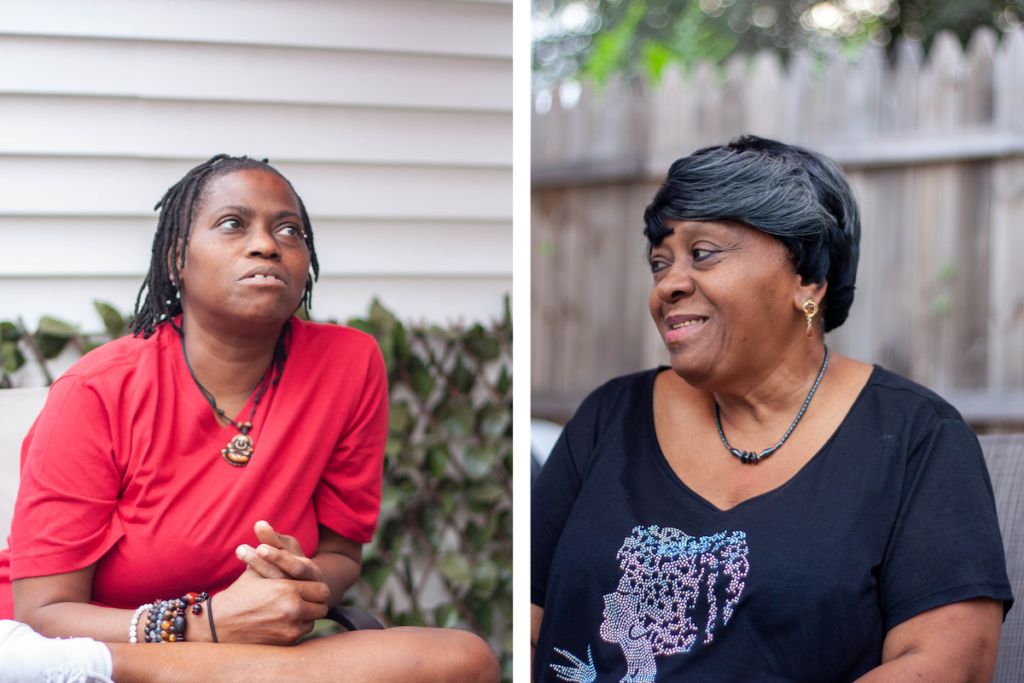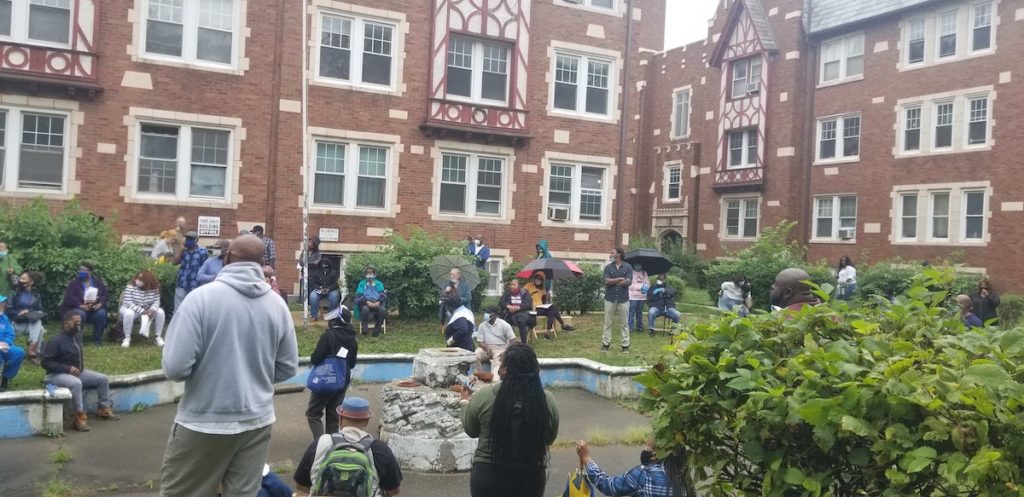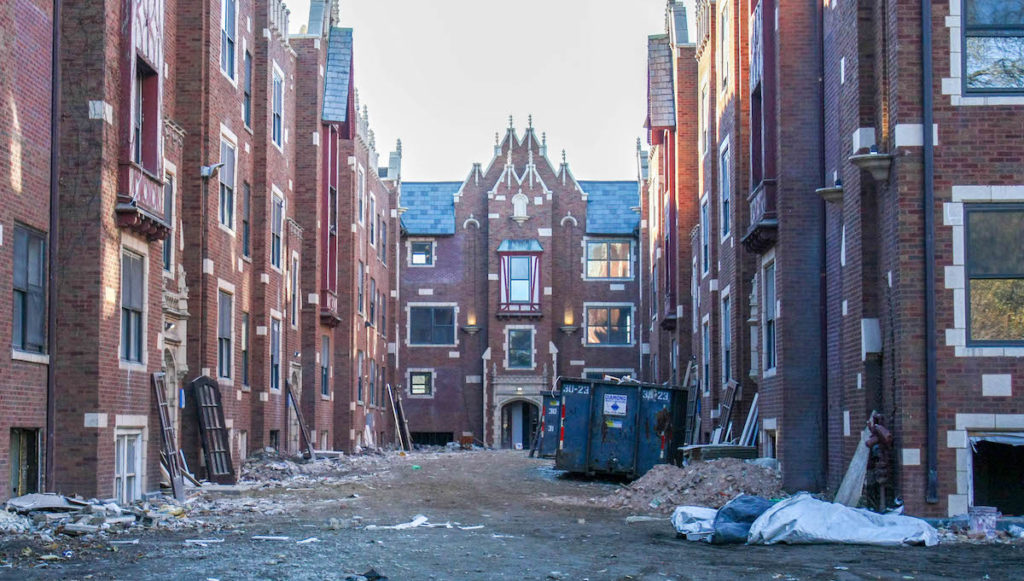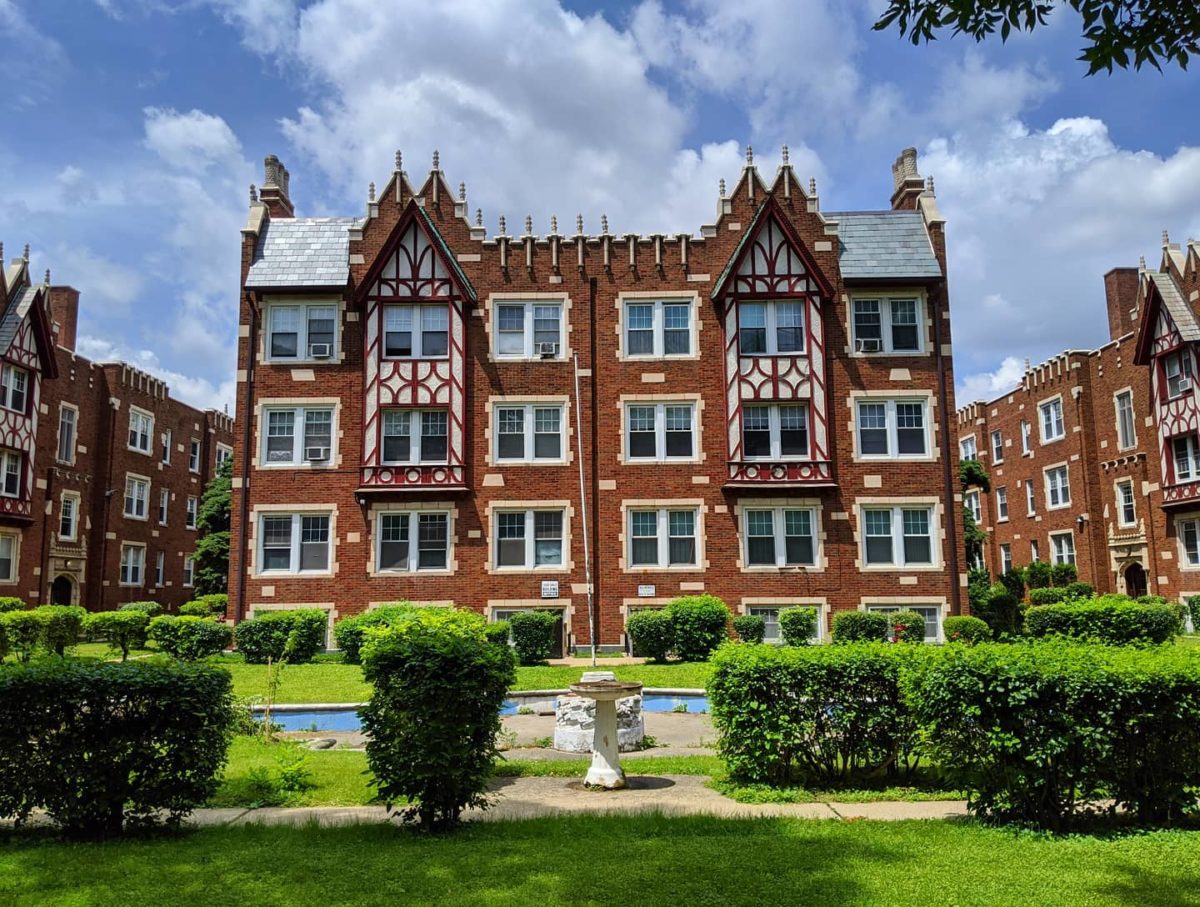Listen to “The Castle on Drexel”
Story by: Emeline Posner Read by: Chima Ikoro Produced by: Erisa Apantaku Music by: Blue Dot Sessions
Listen on Soundcloud
This reporting was supported by the Fund for Investigative Journalism
It was a hot Saturday afternoon in July 2017, and grills were smoking in the empty fountain pool in front of Kenwood’s Tudor Gables housing cooperative. Longtime member Cassandra Dixon was tending to chicken, rib tips, and hot dogs across five grills, while other members fussed over snacks and a custom sheet cake. The smell of it all was wafting into the windows of the building’s hundred-odd units and down the 4800 block of Drexel Boulevard.
Members emerging from the cooperative’s quarterly board meeting trickled down to eat and mingle, and building elders sat in the shade of a tent that Dixon and her mother, Gladys Means, had set up. Neighbors from down the block were stopping over, too. Hell, people no one from the Gables had ever seen were pulling up in cars on Drexel, saying they were stopping by to see a cousin, and could they please have a plate.
Dixon and Means would play a little—“So what’s your cousin’s name?”—before heaping up a plateful for them. “All you had to do was tell us you was hungry,” Dixon would say.
As the sun set over Drexel’s courtyard buildings and mansions, Dixon took a swig of her beer and looked around at the small crowd gathered in front of her lifelong home. A barbeque in front of the Gables, who would have thought? She shook her head and smiled. For as long as Dixon could remember, no one had been allowed to use the lawn—not for play, not for grilling.
Since Dixon was a child, the building elders had made a point of keeping the few kids who lived in the building off the lawn, lest they mess up the courtyard’s neat landscaping or get hurt playing in the fountain pool, which at one time was a neighborhood attraction, full of koi fish and wished-upon coins. The fountain went dry sometime in the 1990s, but the rule stuck, at least until this summer of 2017, when the president of the housing cooperative board approached Dixon and Means about hosting a building-wide picnic. Though the two initially felt conflicted about upending building norms, they decided it was worth it. “This would be a good thing, show unity, bring everyone together ’cause it’s a hard time—let’s do this,” Dixon remembered saying.
Dixon and Means loved the Tudor Gables dearly, but it hadn’t been an easy place to live for some time.
In the mid-2000s, the roof of the grand Tudor Revival–style building had started to fail. With every rainfall and snowmelt, water trickled in through cracks in the mortar. The roof needed a full replacement; the board was only hiring contractors to do patch work. Residents did their best to manage the water on their own with buckets and tarps, but by 2012 as many as thirty units were marked with cracks, warped floors, broken electrical outlets, and mold.
The board was mismanaging more than just repairs. An accountant brought in to audit the building’s 2007–2009 financial records could not verify any of the building’s books. In their report, the accountant highlighted a $50,000 debit from one of the co-op’s bank accounts that the board was either unable or unwilling to explain. “No records have been produced to show where the money went,” the accountant wrote. The board had also been lumping different cash flows together in a way that made it impossible for an auditor to trace funds back to their source.

“There was no accountability for it,” Dixon said. She remembered the accountant warning members, “You need to start paying more attention to what’s going on.”
In the years leading up to 2012, some members stopped paying assessments. Some said they were assured that they wouldn’t need to pay until the roof had been repaired and they were no longer living with leaks. Others didn’t await permission and withheld their payments in protest of the board’s nonaction.
The board’s main response to withheld assessments had been to take nonpaying members to evictions court. In the 116 eviction cases the board filed between 2000 and 2009, it sought back pay, the member’s shares in the cooperative, or both. Nearly two-thirds of these filings resulted in eviction orders.
The deluge of evictions tore at the social fabric of the cooperative while racking up legal fees for the board. “They kept burning off excess money going to court, going to court,” said William House, who had moved into the Gables in 1980. Between 2008 and 2011, House fought and settled two eviction suits by the board over his third-floor unit, which was so water-damaged that he withheld assessments and eventually lived outside the building for several years. “I did not feel like the building was being run right,” House said.
For some, the Gables’ problems became too much. Tired of dealing with water damage, drawn-out eviction battles, and an untrustworthy board, members began leaving the building. Some tried to sell their units while others simply abandoned them, compounding the cooperative’s cash flow problems.
But others were determined to find a path forward. For all its issues, the Tudor Gables was one of the most affordable unsubsidized housing options left in the area. With the cooperative’s low monthly assessments and small apartments, many older members, like House, could afford to live there on fixed incomes. Others were hopeful the Tudor Gables could return to better times.
Dixon in particular recalled the building of her childhood and early adulthood with fondness and pride. “It was a proud moment living on the boulevard, living at Tudor Gables,” Dixon said. “You was happy when your friends came, your family came, and saw this castle. And that’s what everybody called it. ‘You live in the castle on Drexel?’ ‘Yup.’ ‘With the white fountain in front?’ ‘Yup, with the white fountain in front.’”
The Castle on Drexel
The Tudor Gables was built in 1928, one of many dense, multifamily buildings that went up on Drexel Boulevard in the first half of the twentieth century. “An imposing addition to an imposing parked thoroughfare,” a Tribune journalist wrote of the building that year. Like many of the other courtyard buildings that line the boulevard today, the Tudor Gables was built to replace the mansion of a wealthy Chicagoan. Immediately to the north of the Tudor Gables site was meatpacking businessman Edward Morris’s “palatial” home; this too would be torn down and replaced in the 1950s with an affordable, sixty-four-unit townhome development designed by Bertrand Goldberg, which still stands.
When Tudor Gables was built, the boulevard was predominantly white, the boundary line between white Hyde Park and Black Bronzeville. By the late 1940s, however, the boulevard started to integrate, spurred by the city’s growing Black population and the Supreme Court’s 1948 decision that racially restrictive covenants, which white homeowners across the city used to prevent their homes from being bought or rented by Black Chicagoans, were no longer legally enforceable.
At the same time, the city was seeing a resurgence of interest in housing cooperatives. During the first cooperative housing boom of the 1920s, housing cooperatives primarily belonged to white upper- and upper-middle-class Chicagoans; few of these survived the Great Depression years. In the 1940s came a second wave of housing cooperative development “centered mostly on converting big completed rental apartment buildings into mutual ownership projects,” the Tribune reported in 1949. Black Chicagoans had been developing cooperative businesses like groceries and credit unions for years, but in the 1940s increasingly saw the potential in housing cooperatives as a way to build equity and escape the horrid conditions in Chicago’s segregated housing market.
Among this new wave of housing cooperative proponents was a Black real estate agent by the name of Journée White. He promoted his vision for cooperative development in the pages of the Chicago Defender newspaper. “We intend to make it more than a statement to the thousands in this community who are looking for the Answer to their quest for Decent Housing,” White wrote in one of his ad placements in the Defender. In 1948, he bought the Tudor Gables, and less than a year later he had sold all but six of the 114 units to Black families, the Tribune reported. In May 1950, the Tudor Gables Building Corporation filed papers describing itself as a housing cooperative with the Secretary of State’s office, making it one of the first Black-owned cooperatives in the city.
Dixon’s grandmother, Nora Means, was the first of the family to move into the Tudor Gables, sometime in the 1950s. She had lived nearby, at 47th Street and Drexel, for years, as had her mother. As Dixon tells it, her grandmother saw the Tudor Gables as a stepping stone to a single-family home. But somewhere along the way, the pathway became more appealing than the initial destination, and Nora Means stayed. Eventually her daughter, Gladys Means, embraced it as her home, too, and decided to raise Dixon in the building.
In these first few decades, the Tudor Gables established itself as a model of cooperative success.
“It is believed that Tudor Gables is the largest debit free housing cooperative owned by colored people in America,” reported the Baltimore Afro-American newspaper in 1964, when the building announced that it had paid off its two mortgages early. In 1969, the building secured a $213,400 improvement loan from the Department of Housing and Urban Development, and this sparked interest from the Tribune, which identified the loan as the “largest [loan] received by black homeowners in the nation” under the rehabilitation provision of the 1965 National Housing Act, and the second-largest loan the department had ever issued within the Midwest.
The Gables was part of a rich network of cooperative and community groups that emerged along Drexel, including block clubs, other Black-owned housing cooperatives, condominium associations, a cooperative daycare, and civil rights organizations such as the Rev. Jesse Jackson’s Operation PUSH.
Inside the building and out, Gables members organized for community wellness, advocating for neighborhood resources and running for positions on local community organizations like the Hyde Park-Kenwood Community Conference. In 1958, Gables members formed a group called the Benevolent Association to provide care to neighbors who were sick or needed assistance. But the association also looked outward to the larger community, bringing in neighborhood movers and shakers to talk about their work. One such meeting was in November 1963, when a parent came to speak about the Kenwood Community Study Center she had started, which offered volunteer afterschool help for kids who needed assistance with schoolwork. “The benevolent club decided at the meeting to lend a hand, collectively and individually, to the study center, after hearing Ms. [Lillian] King’s inspiring message,” the Chicago Defender reported.
The strong ethic of collectivism and neighborly care shaped the lives of many. As a young child, Means remembered being stopped by her downstairs neighbor one morning on her way out the door to school. The neighbor wanted to know why her hair wasn’t combed. When Means told her that her mother had broken her arm and couldn’t comb it for her, the neighbor insisted on combing her hair in the mornings and running food upstairs for them in the evenings until her mother’s arm had healed.
State of Deterioration
Conditions at the Tudor Gables started to change in the early 2000s, according to several members interviewed by the Hyde Park Herald.
Following the passing of longtime board president Annie White in 2005, the board cycled through several presidents.
Dixon said the building’s money seemed to evaporate in this period. Where there had previously been money for necessary building maintenance as well as nice things, like planters in front of each of the building’s twenty entrances, now there was hardly any.
Under the leadership of one subsequent board president, Jerrold DeRon, the building got caught in the revolving door of buildings court. The building had been cited as early as 2003 for a rodent infestation, missing carbon monoxide detectors, and minor masonry issues. But by 2010, the City was citing the cooperative for its failure to maintain all of the following: exterior walls, roof, roof copings, lintels, areaway walls, exterior stairways, porches, interior walls, and ceilings.
In 2011, Fran Froehlich, a retired woman who had moved into the building in 2004, accused the board of hanging onto old traditions of governance that no longer served the building. “Historically here, the building has been governed verbally and only those within that verbal circle were ‘in the know,’” Froehlich wrote in an email that year to the board.
“I have enormous respect for Annie White and the years she dedicated to this building, but her time is past,” Froehlich continued. “Change procedures to the written, open up your lines of communication and be forthright. Establish an audit trail of our monies and your actions. If there are not changes here, the City will wind up, through the court system, changing it for you.”
According to other emails between shareholders and the board, the building would often hire unlicensed contractors or secure a permit for work and then let it lapse.
When the board finally hired someone to redo the entire roof in 2010, the roofer disappeared halfway through the job, leaving the roof stripped and covered in tattered blue tarps. It was then that the City filed a lawsuit against the building in Cook County Circuit Court.
Former co-op members the Herald spoke with recalled feeling serious concern around this time that the City would condemn their building or place it into receivership. In the first case, everyone could be relocated until the code violations were fixed. In the second, the court would appoint a company to run the building’s management and finances for an indefinite period.
No one wanted the building to be condemned, but members were split over whether receivership would save the cooperative or end it. Under receivership, members would be able to remain in the building, but they’d lose their say in building governance.
While some members withheld their payments as a form of protest against the board, Froehlich wielded the possibility of receivership as her weapon of choice. In her sprawling emails to the board, she’d often sign off with a reminder that receivership would remove board members from their place of power within the building. “Don’t goof around—get this building fixed the way it should be. It is almost in a state of deterioration where it is becoming unhealthy to live here, particularly those of us on the third floor,” Froehlich wrote in a June 2010 email. “It is your actions that will determine whether a receiver is appointed that takes over the Board’s job.”
Froehlich soon became one of the unofficial leaders within the building, Dixon said. She counseled members on their housing rights and sent emails to the building listhost in advance of administrative hearing and court dates, criticizing the nonaction and secrecy of the board. Froehlich was a somewhat divisive figure; some trusted her and some didn’t, but it couldn’t be disputed that she had an impressive grasp on real estate and the law—though nobody knew exactly where that expertise came from, or what she had done for a living before moving into the cooperative. By 2014, she was elected president.
A year later, Froehlich had secured a $1.4 million loan to do triage work on the roof and to begin rehab work inside the apartments. In 2016, enough work had been done on the roof for the City to settle its lawsuit against the building.
In 2018 the Chicago Community Loan Fund approved a $3.4 million construction loan for the building, the second-largest loan the fund approved that year. The board used it to pay off the first loan and then embarked on an ambitious rehab project. To Dixon, House, and other shareholders, it seemed possible for the first time in several years that the cooperative might be on the road toward recovery.
The Gables dissolves
That optimism turned out to be short-lived. Three years later, the cooperative was on the verge of collapse.
In August 2020, a new board—Froehlich had been ousted as president in 2018—announced that a developer had made an offer on the building and that members had little choice but to accept due to the building’s poor finances. The board urged shareholders to vote to sell the building, saying that members could take the payout from the developers or risk mortgage foreclosure down the road—in which case they’d leave with nothing to show for all the years of love, sweat, and tears they’d lived through in the Tudor Gables.

Under a September drizzle, the remaining members of the Tudor Gables Building Corporation gathered around the edges of the fountain pool to vote on the sale of the building. By a small margin, the resolution to sell was approved.
In March 2021, the board closed on the off-market, $11.5 million sale with the new owners, 312 Properties. The new lakefront developer has spent more than $50 million since 2014 buying up large multifamily buildings between Bronzeville and South Shore, including three other buildings on Drexel. Interviews with tenants at other properties owned by 312 Properties revealed that the developer has created or allowed dangerous conditions to persist in many of its buildings.
The new owners insisted that members leave the building within three months, setting off a panic among residents, many of whom had not yet received their share of the money from the sale and had to scramble to find new housing.
At least four members and two children were still living in the building when 312 Properties began a full gut rehab of the building that June. The following month, the developers started shutting off residents’ water and utilities, the Herald reported, and by September 2021 they had forced the last residents out.
Dixon and her mother relocated to Bronzeville, but the majority of the Tudor Gables community has dispersed to all corners of the city, to the suburbs, some even out of state. The majority said they could no longer afford to live in Kenwood due to unaffordable rents.
“They made a lot of people homeless,” said House, whose unit’s rehab was completed in 2020 after his ceiling collapsed six years earlier; it was finished just before the board proposed the building sale. “I’m a senior citizen, and I’m on a fixed income; I can’t get no market-rate apartment. I’m on a waiting list that could be years from the CHA.”

Today, the former Tudor Gables building is midway through its second winter of active construction. Four dumpsters sit in the front yard, which is torn up beyond recognition, with no trace of the famed fountain remaining. Some units sit with windows open, exposed to the elements.
The sight of the building is painful to Dixon. “I can’t drive down Drexel anymore,” she said.
Former residents say the surprise sale of the Tudor Gables, and the board’s dubious management of repairs and finances in the preceding ten years, left them in the dark—and angry.
When Dixon received a letter from the board of directors in early November saying that the last of the building’s bills had been paid and that members would be receiving one last distribution of $140 to $400, she felt renewed anger. As with the preceding payouts to members, the board provided no receipts, no bank statements, nothing to confirm that there were actually other bills for the board to pay. “There is no transparency,” said Dixon. “I don’t trust y’all. You’re just giving us words.”
“We have been completely lost for words,” said Pia Johnson, a shareholder who was unable to live in her family’s longtime unit from 2015 to 2020 due to severe water damage. She says that she has yet to receive any money from the sale, due to an unresolved dispute with the board over her unit, and has been unable to reach any of the board members since the sale. “You can’t even use the word bamboozle for what has happened in this situation,” Johnson said.
All former shareholders interviewed by the Hyde Park Herald said that they have been unable to get in contact with any members of the last several boards, including Froehlich. The Hyde Park Herald reached out to all former board members for comment; none were willing to speak on the record.
Almost two years later, members haven’t given up on the building. They want to know: what went wrong at the Tudor Gables? Where does responsibility lie? And where might they find accountability?
The next story in the series will examine the rehab and sale of the Tudor Gables building, and allegations of mismanagement and conflicts of interest among board members.
Correction 2/6/23: The article has been updated to reflect the fact that Gladys Means, not Cassandra Dixon, had a neighbor check in on her while her mother was recovering from a broken arm. We regret the error.
Emeline Posner is a contributor at the Herald and the Weekly.




WOW
This is a great recount of important history and I am thankful for it.
Incredible story!